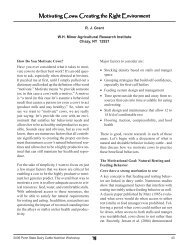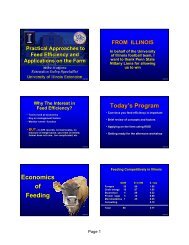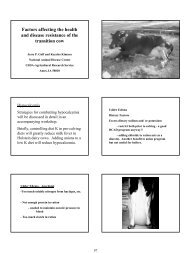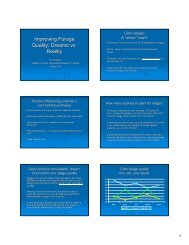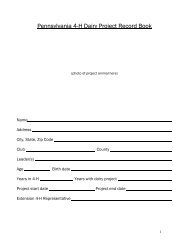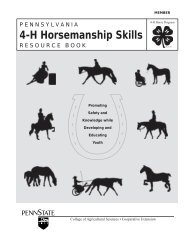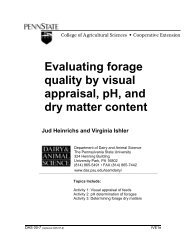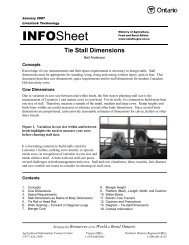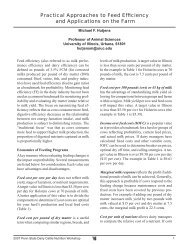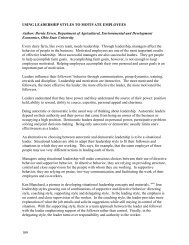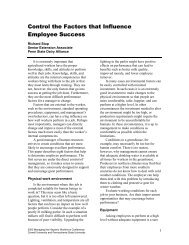DETERMINING THE MINERAL REQUIREMENT OF DAIRY CATTLE
DETERMINING THE MINERAL REQUIREMENT OF DAIRY CATTLE
DETERMINING THE MINERAL REQUIREMENT OF DAIRY CATTLE
You also want an ePaper? Increase the reach of your titles
YUMPU automatically turns print PDFs into web optimized ePapers that Google loves.
effusion and petechial hemorrhages in many organs, especially kidneys. Often the breath<br />
will smell of hydrogen sulfide - which is likely the toxic form of S. Sulfates are less toxic,<br />
though they can cause an osmotic diarrhea as the sulfate is only poorly absorbed. Excess<br />
sulfate added to rations can reduce feed intake and performance. Water containing more<br />
than 5000 mg S/kg reduces feed and water intake. Recent observations in beef cattle<br />
have determined that a polioencephalomalacia-like syndrome can be induced with diets<br />
containing 0.5% S using sulfate salts as supplemental S sources or from drinking water<br />
high in sulfates. The strong reducing environment within the rumen can reduce dietary<br />
sulfate, sulfite and thiosulfate to sulfide within the rumen.<br />
Cobalt<br />
Cobalt is a component of vitamin B12 (cobalamin) which is a cofactor for 2 major<br />
enzymes; methylmalonyl coenzyme A mutase necessary for conversion of propionate to<br />
succinate, and tetrahydrofolate methyl transferase which catalyzes transfer of methyl<br />
groups from 5-methyltetrahydrofolate to homocysteine to form methionine and<br />
tetrahydrofolate. Microbes are the only natural source of vitamin B12. Rumen microbes<br />
can produce all the vitamin B12 required by ruminants provided adequate available cobalt is<br />
in the diet.<br />
Rumen microbes need 0.11 % Cobalt rations to perform efficiently.<br />
Cobalt Cl and nitrate, and cobaltous carbonate and sulfate all appear to be suitable<br />
sources for cobalt in ruminants. Cobaltous oxide, being much less soluble, is somewhat<br />
less available (Henry, 1995). Cobaltous oxide pellets and controlled release glass pellets<br />
containing cobalt which remain in the rumen-reticulum have been used successfully to<br />
supply cobalt over extended periods of time to ruminants on pasture, though regurgitation<br />
can cause loss of some types of pellets.<br />
Deficiency<br />
Ruminants appear to be more sensitive to vitamin B12 deficiency than non-ruminants,<br />
largely because they are so dependent on gluconeogenesis for meeting tissue glucose<br />
needs. A breakdown in propionate metabolism at the point where methylmalonyl-CoA is<br />
converted to succinyl-CoA may be a primary defect arising from vitamin B12 deficiency.<br />
The appearance of methylmalonic acid in urine may be used as an indicator of vitamin B12<br />
deficiency. Vitamin B12 deficiency may limit methionine production and limit nitrogen<br />
retention.<br />
Without cobalt in the diet, rumen production of vitamin B12 rapidly (within days)<br />
declines. Vitamin B12 stores in the liver of adult ruminants are usually sufficient to last<br />
several months when they are placed on a cobalt deficient diet. Young animals are more<br />
sensitive to dietary cobalt insufficiency because they have lower liver vitamin B12 reserves.<br />
Early signs of cobalt deficiency include failure to grow, unthriftiness, and weight loss. More<br />
severe signs include fatty degeneration of the liver, anemia with pale mucous membranes,<br />
and reduced resistance to infection as a result of impaired neutrophil function.<br />
While the cow may have adequate stores of vitamin B12 to last several months, the<br />
rumen microbes apparently do not. Within a few days of a switch to a cobalt deficient diet<br />
rumen concentrations of succinate rise, either as a result of inability of rumen microbes to<br />
convert succinate to propionate or a shift in rumen bacterial populations toward succinate<br />
rather than propionate production.<br />
Copper (Cu)<br />
The trace mineral where deficiency is common and toxicity is also common!!!!<br />
44




